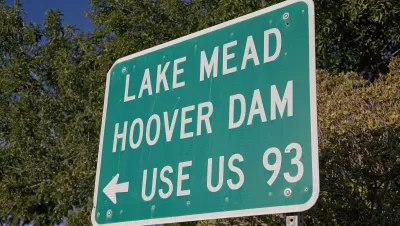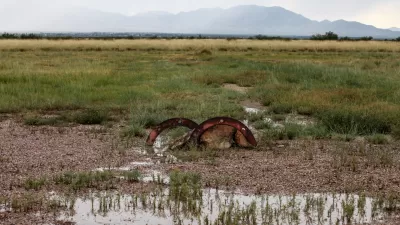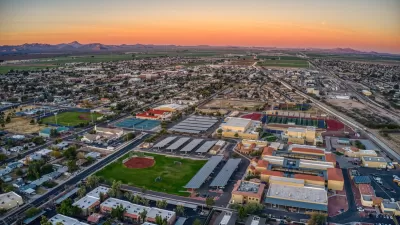As more and more people move to the suburbs blossoming in the Phoenix metro area, local water officials are increasingly concerned about the region's ability to keep up with demand.

Since before the pandemic, Phoenix has seen explosive growth as people seek out its affordable housing, warm climate, and work opportunities. But as Sarah Tory reports in High Country News, "[t]he region doesn’t appear to have enough water for all the planned growth."
Despite the looming threat of a dwindling water supply in the American Southwest, "people keep moving here — to the hottest, driest part of the country," Tory writes. The population of the Phoenix area is expected to grow to more than 7 million by 2040, with author and sociologist Andrew Ross calling it the "least sustainable city on earth." In addition to a small amount of groundwater and treated wastewater, "[m]ost of the valley’s water supply comes from the winter snowpack in distant mountains, which melts and flows through a vast system of dams, reservoirs and canals."
"A 2019 report published by the Kyl Center warns that in the long term there likely won’t be enough surface water available from the Central Arizona Project to replenish the groundwater used by all the homes currently planned for the Phoenix suburbs." The ambitious growth plans of many local cities pose serious questions about where future water supplies will come from. "Next year, water levels on Lake Mead, the largest reservoir on the Colorado River, are projected to drop to their lowest levels yet, triggering the first-ever official shortage declaration by the federal government. The declaration will cut Arizona’s Colorado River supplies by a fifth." As Tom Buschatzke, director of the Arizona Department of Water Resources put it, "[w]e’ll have to make some hard decisions."
FULL STORY: Rapid growth in Arizona’s suburbs bets against an uncertain water supply

Study: Maui’s Plan to Convert Vacation Rentals to Long-Term Housing Could Cause Nearly $1 Billion Economic Loss
The plan would reduce visitor accommodation by 25,% resulting in 1,900 jobs lost.

North Texas Transit Leaders Tout Benefits of TOD for Growing Region
At a summit focused on transit-oriented development, policymakers discussed how North Texas’ expanded light rail system can serve as a tool for economic growth.

Using Old Oil and Gas Wells for Green Energy Storage
Penn State researchers have found that repurposing abandoned oil and gas wells for geothermal-assisted compressed-air energy storage can boost efficiency, reduce environmental risks, and support clean energy and job transitions.

Santa Barbara Could Build Housing on County Land
County supervisors moved forward a proposal to build workforce housing on two county-owned parcels.

San Mateo Formally Opposes Freeway Project
The city council will send a letter to Caltrans urging the agency to reconsider a plan to expand the 101 through the city of San Mateo.

A Bronx Community Fights to Have its Voice Heard
After organizing and giving input for decades, the community around the Kingsbridge Armory might actually see it redeveloped — and they want to continue to have a say in how it goes.
Urban Design for Planners 1: Software Tools
This six-course series explores essential urban design concepts using open source software and equips planners with the tools they need to participate fully in the urban design process.
Planning for Universal Design
Learn the tools for implementing Universal Design in planning regulations.
Ascent Environmental
Borough of Carlisle
Institute for Housing and Urban Development Studies (IHS)
City of Grandview
Harvard GSD Executive Education
Toledo-Lucas County Plan Commissions
Salt Lake City
NYU Wagner Graduate School of Public Service





























